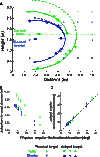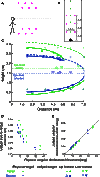Intrinsic spatial knowledge about terrestrial ecology favors the tall for judging distance
- PMID: 27602402
- PMCID: PMC5007070
- DOI: 10.1126/sciadv.1501070
Intrinsic spatial knowledge about terrestrial ecology favors the tall for judging distance
Abstract
Our sense of vision reliably directs and guides our everyday actions, such as reaching and walking. This ability is especially fascinating because the optical images of natural scenes that project into our eyes are insufficient to adequately form a perceptual space. It has been proposed that the brain makes up for this inadequacy by using its intrinsic spatial knowledge. However, it is unclear what constitutes intrinsic spatial knowledge and how it is acquired. We investigated this question and showed evidence of an ecological basis, which uses the statistical spatial relationship between the observer and the terrestrial environment, namely, the ground surface. We found that in dark and reduced-cue environments where intrinsic knowledge has a greater contribution, perceived target location is more accurate when referenced to the ground than to the ceiling. Furthermore, taller observers more accurately localized the target. Superior performance was also observed in the full-cue environment, even when we compensated for the observers' heights by having the taller observer sit on a chair and the shorter observers stand on a box. Although fascinating, this finding dovetails with the prediction of the ecological hypothesis for intrinsic spatial knowledge. It suggests that an individual's accumulated lifetime experiences of being tall and his or her constant interactions with ground-based objects not only determine intrinsic spatial knowledge but also endow him or her with an advantage in spatial ability in the intermediate distance range.
Keywords: Human behavior; adaptation; ecology; perception.
Figures




References
-
- H. A. Sedgwick, Space perception, in Handbook of Perception and Human Performance, K. R. Boff, L. Kaufman, J. P. Thomas, Eds. (Wiley, New York, 1986).
-
- Gogel W. C., Tietz J. D., Absolute motion parallax and the specific distance tendency. Percept. Psychophys. 13, 284–292 (1973).
-
- Philbeck J. W., Loomis J. M., Comparison of two indicators of perceived egocentric distance under full-cue and reduced-cue conditions. J. Exp. Psychol. Hum. Percept. Perform. 23, 72–85 (1997). - PubMed
-
- Ooi T. L., Wu B., He Z. J., Distance determined by the angular declination below the horizon. Nature 414, 197–200 (2001). - PubMed
-
- Ooi T. L., Wu B., He Z. J., Perceptual space in the dark affected by the intrinsic bias of the visual system. Perception 35, 605–624 (2006). - PubMed
Publication types
MeSH terms
Grants and funding
LinkOut - more resources
Full Text Sources
Other Literature Sources

